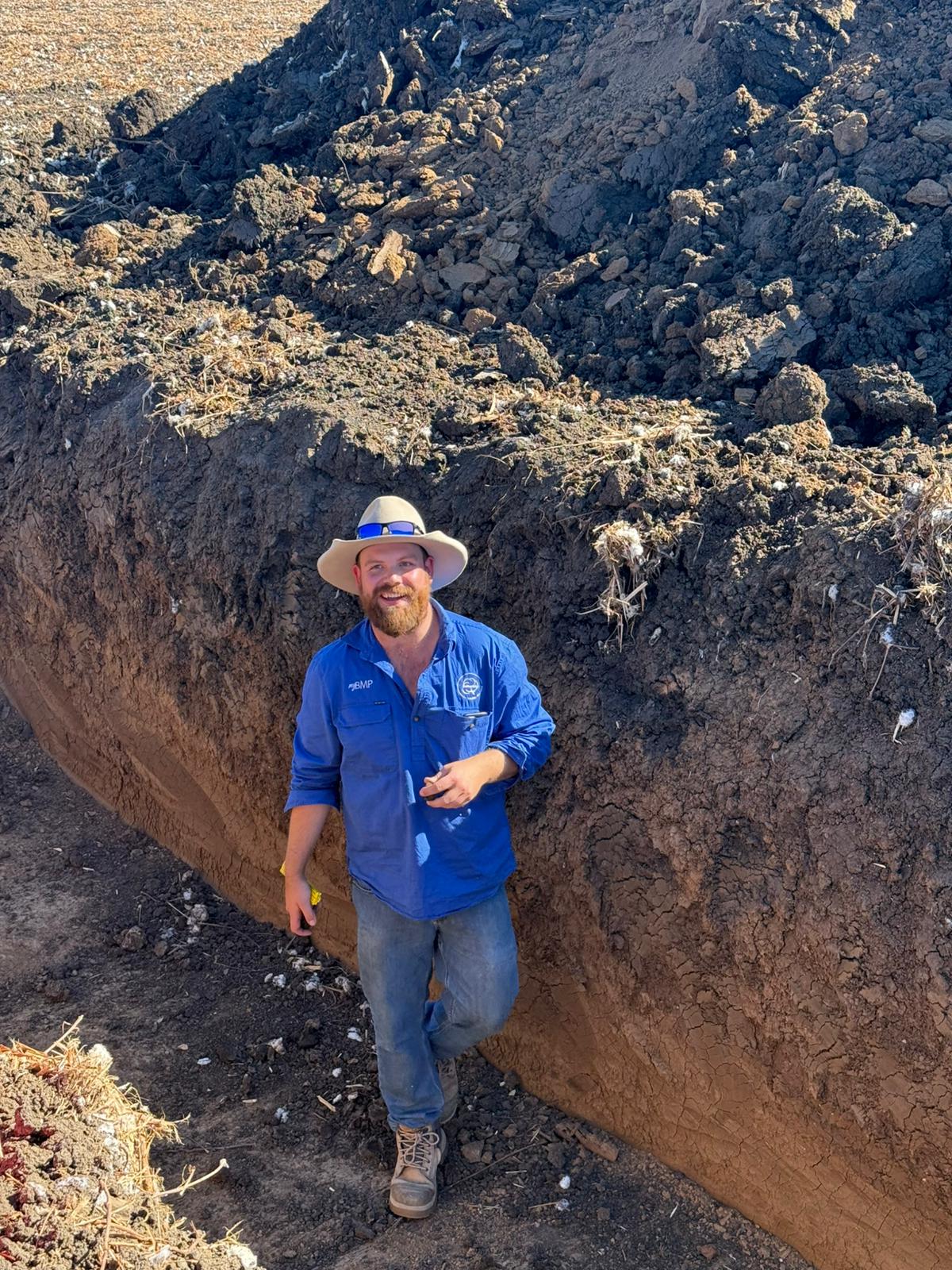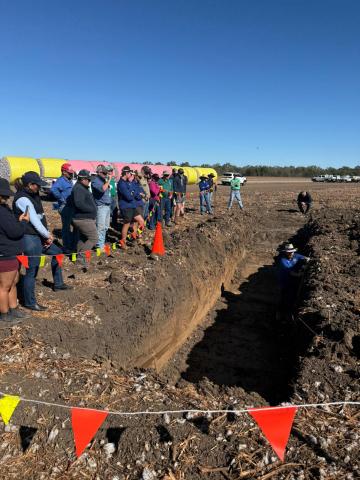Nitrogen Use Efficiency – Key Learnings
One of the most valuable insights from the Soil and Nutrition workshop held in Emerald in June 2025 was the importance of treating the cause of poor nitrogen use efficiency (NUE) not just the symptoms. High nitrogen rates and low efficiency often stem from reactive management. Long-term soil health and nitrogen efficiency improve when we focus on what’s really behind poor NUE.
Improving NUE requires careful investigation of the causes of the inefficiency before modifying seasonal N fertilizer tactics. Improvement of efficiency may be achieved more reliably by modifying soil physical characteristics and irrigation practices without changing seasonal N tactics. Source: NutriPAK
The Three Pillars of Nitrogen Use Efficiency
Water
Structure
Nitrogen
These factors are interconnected. Poor soil structure can lead to waterlogging, reducing nitrogen uptake. Managing these relationships improves crop performance.
The 4Rs of Nutrient Stewardship
Right Product
Right Rate
Right Time
Right Place
This framework ensures nitrogen is available when and where the crop needs it most, reducing waste and improving uptake.
Sources of Nitrogen in the Soil
Crop Residues – Leaf drops contain 1.5–2.5% nitrogen, returning to the soil within 6–8 weeks.
Soil Organic Matter – Slowly releases nitrogen throughout the season.
Soil Mineral Nitrogen – Naturally occurring nitrogen in the soil.
Fertilizer Products – Directly applied nitrogen.
Fun Fact: Soil organic matter acts like a slow-release fertilizer, feeding the crop steadily over time.
Nitrogen Uptake & Timing
20–30% is taken up pre-flowering.
50% is absorbed in the six weeks between first and peak flowering.
Timing is everything. Products applied at squaring may only last 6 weeks—just enough to cover peak demand. Every irrigation event is a potential nitrogen loss event.
Risk Periods for Nitrogen Loss
Pre-watering during fallow
Pre-plant fertilizer application
First two in-crop irrigations
Losses are greatest when soil temperatures exceed 25°C. Under waterlogged or compacted soils, growers can lose up to 40% of applied nitrogen.
Tip: Urease inhibitors can reduce surface losses for 12–14 days.
Enhanced Efficiency Fertilisers (EEF): Research & Resources
EEF fertilisers were also a key topic of discussion during our workshop. These products are designed to improve nutrient uptake and reduce losses, especially under challenging seasonal conditions.
Link below is interesting outcome for work done with inhibited urea by Incitec Pivot.
For a concise overview, we’ve attached the CottonInfo factsheet on EEFs. It outlines key benefits, application strategies, and considerations for integrating EEFs into your nutrient management plan Urease inhibitors: How they protect N fertilizer | CottonInfo
On another note, Cotton Research and Development Corporation (CRDC) 2025 Winter Spotlight Magazine is out, great piece. Pages 21-22 are well worth a read, which talks about how Nutrition Use Efficiency can be improved and emissions reduced by harnessing the power of microbes. Great content that is worth considering.
🌱 1. Microbes Drive Nitrogen Cycling
Soil microbial communities are central to nitrogen (N) transformation processes, including mineralisation, nitrification, denitrification, and nitrogen fixation. These processes directly affect nitrogen availability to crops and the potential for greenhouse gas (GHG) emissions.
🌾 2. Nitrous Oxide Emissions Are a Major Concern
Nitrous oxide (N₂O), a potent GHG (which is 246 more powerful than carbon dioxide) with no terrestrial sink, is a byproduct of microbial nitrogen cycling. Understanding microbial activity is essential for managing and reducing these emissions in cotton systems.
🧪 3. Management Practices Influence Microbial Activity
Soil type, fertiliser application, crop rotation, and environmental conditions (e.g., moisture, temperature) significantly affect microbial populations and their functions in the nitrogen cycle
🌍 5. Soil Organic Carbon Is Key
Higher levels of soil organic matter support greater microbial abundance and activity, particularly in the topsoil, enhancing nitrogen mineralisation and availability.
2025 Winter Spotlight Magazine, page 23 with more information on Understanding cotton nutrition with NUTRIpak | CottonInfo as a source of information on nutrition.
QDPI is just commencing a new project that will include looking at innovations to support low-carbon cotton production system. If you are interested in participating in research, please let me know and I can help connect you with the right people.
Disclaimer: As CottonInfo, our role is to connect you with relevant research and resources. We do not endorse specific products but aim to support informed decision-making through access to credible information.
Soil Structure, Organic Matter & Crop Rotation
Our soil compaction session revealed that soils with cover crops incorporated into rotation had noticeably better structure. This reinforces the importance of crop rotation for long-term soil health.
Cover crops also increase soil organic carbon, improving structure, water retention, and nutrient cycling. Better soil structure means less compaction, improved root growth, and more efficient nutrient uptake—especially nitrogen.
Fun Fact: More than two hours of anaerobic conditions can shut down Nitrogen absorption entirely!
Workshop Highlight: The Soil Pit
The day ended with a hands-on look at soil structure in the field. The soil pit demonstration brought everything together—compaction, root development, and water movement—all visible and tangible.

CottonInfo has recently posted a new factsheet: Wet Picking & Soil Compaction | CottonInfo.
This comprehensive fact sheet from Cotton Info’s Soil Health Tech Lead, Blake Palmer, (pictured at soil pit at the workshop) looks at how best to assess the impact of soil compaction following a wet pick, and how to best repair the damage.
If I had one key message to give about compaction it would be this “It happens. When it does the key to fixing it is dryness – whether using tillage or rotation crops, the soil either needs to be dry enough for tillage to shatter the compacted layers or needs to dry out over multiple wetting-drying cycles for rotation crops to bioremediate the soil structure. “Final Thoughts from Blake Palmer.
Thanks again to everyone who joined us. Your engagement made the workshop a success, and the conversations were rich with practical insights. For those who couldn’t attend, we hope to see you at future events. Feel free to reach out if you’d like workshop notes or to discuss your nitrogen strategy. As CottonInfo, we are here to support you. Knock anytime and we will be happy to answer!
By Tami Buranda, CottonInfo REO, CQ
June 2025

